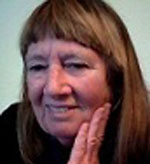Judy Malloy
 A pioneer in electronic literature, Judy Malloy followed a vision of hypertextual narrative that she began in the 1970’s with experimental artist books. In the 1980’s, she wrote and programmed the seminal hyperfiction, Uncle Roger. In the ensuing years, she created a series of innovative hypernarratives — including its name was Penelope, (Eastgate) and From Ireland with Letters — that have been internationally exhibited and published.
A pioneer in electronic literature, Judy Malloy followed a vision of hypertextual narrative that she began in the 1970’s with experimental artist books. In the 1980’s, she wrote and programmed the seminal hyperfiction, Uncle Roger. In the ensuing years, she created a series of innovative hypernarratives — including its name was Penelope, (Eastgate) and From Ireland with Letters — that have been internationally exhibited and published.
Malloy’s work with narrative as information was influenced by her early work as searcher-editor for the Library of Congress, and she is delighted that its name was Penelope is included in this exhibition.
To learn more about Judy’s work, visit: http://www.well.com/user/jmalloy/
Contact: jmalloy@well.com
its name was Penelope (Eastgate, 1993, iPad edition in press) is a collection of memories in which a woman photographer recollects the details of her life. Considered one of the classic works of electronic literature, its name was Penelope invites the reader to explore an artist’s life — from “Dawn”, the Homeric sunrise, the beginning of life; to the details of the narrator’s photography-based artwork in “Fine Work and Wide Across”; to the troubles related in “Rock and Hard Place”; to a concluding “Song” of love and a shared life.
Like a photos in a photo album, each lexia represents an image from Anne’s memory — so that the work is the equivalent of a pack of small paintings or photographs that the computer continuously shuffles. The reader sees things as she sees them, observes her memories come and go in a natural, yet nonsequential manner. The work unfolds a constantly changing order — like the weaving and reweaving of Penelopeia’s web.
Crafted like poetry, the cadence and tone of each paragraph/stanza in this hypernarrative are carefully constructed so that in whatever order they are seen, the reading experience appears natural. The computer-mediated interface seamlessly immerses the reader in an electronic poetry chapbook where the “pages” are magically brought up at the will of the computer. Poetic narrative is shuffled, continuously changes order, submerges, resurfaces, repeats, and seductive repetition situates the reader in a place of remembered narrative.
